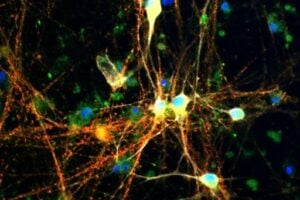VIDEO+ARTICLE
Simple eye tests have the potential to transform the way Alzheimer’s is detected and managed. Find out how two quick, low-cost Alzheimer’s eye tests are successfully advancing in clinical trials.
Breakthrough eye tests are being developed to diagnosis Alzheimer’s quickly and inexpensively. The idea is simple. In some ways, the back of the eye is an extension of the brain. When Alzheimer’s strikes, the amyloid plaques that appear in the brain also appear in the eye.
NeuroVision Imaging and Cognoptix are two companies that are developing Alzheimer’s eye tests that are complicated to design but simple to take. They have made great progress and their test devices are currently in trials.
Neurovision Imaging’s device is discussed in the following video.
The Cognoptox test is called the “The SAPPHIRE II”. This eye test successfully identified Alzheimer’s disease patients via a beta amyloid (“Ab”) signature in their eyes in a 10-subject proof-of-concept clinical trial. By detecting a specific fluorescent signature of ligand-marked beta amyloid in the supranucleus region of the human lens, SAPPHIRE II achieved a 200% differentiation factor between a group of five healthy volunteers and a group of five patients diagnosed with probable Alzheimer’s disease.
“There is a significant effort underway in the scientific and medical communities that is investigating the function of beta amyloid neuritic plaques in the brains of adult patients with cognitive impairment and possible Alzheimer’s disease,” said Carl Sadowsky, M.D., F.A.A.N., Medical Director at Premiere Research Institute in West Palm Beach Fla., and a principal investigator in the SAPPHIRE clinical study. “While it is true that Positron Emission Tomography (PET) imaging has been approved to enable detection of beta amyloid neuritic plaques in living AD patients, there is, nevertheless, a dire need for a low cost, noninvasive technology capable of upgrading the differential diagnosis of dementia, which would be extremely practical for widespread use at the point-of-care.”
(CLICK HERE FOR A SCIENTIFIC PRESENTATION ABOUT THE COGNOPTIX EYE TEST FOR AD.)
“There currently is no early-stage noninvasive test for Alzheimer’s disease,” added Paul Hartung, President and CEO of Cognoptix. “This is unfortunate, given that patients often incur as much as 50% neuronal loss and a delay of up to two years before demonstrating severe enough symptoms to achieve diagnosis of AD by the current gold standard: which is a process of elimination of other possible diagnoses such as stroke, trauma, Parkinson’s disease and dementia, through a battery of cognitive and physical testing. On the other hand, new therapeutic drugs to slow or stop the progress of AD are expected to reach the market soon. Cognoptix is developing a method of early-stage diagnosis to allow treatment before significant neuronal loss and irreversible brain damage occurs.”
There are nearly 100 new Alzheimer’s drugs that are in various stages of research and development. The ability of the Cognoptix drug/device combination to easily identify and qualify patients for clinical study inclusion, as well as accurately and inexpensively track patient disease progression, may provide pharmaceutical companies with a significant competitive advantage in securing new Alzheimer’s drug approvals. It may also help identify and document differentiating pharmaceutical product performance attributes in Phase 4 studies.
About SAPPHIRE II
Cognoptix has developed an in-office, drug/device diagnostic system designed as an aid in the early detection of Alzheimer’s Disease (AD) pathology. A ligand or contrast agent (drug) and software-controlled optical instrument (device) allows for noninvasive detection and assessment of AD by measuring the hallmark of AD, beta amyloid, in the supranuclear region of the lens of the eye. The ligand is easily administered to the eye as an ophthalmic ointment and a proprietary Fluorescent Ligand Scanning (FLS) instrument, provides an objective and quantitative measurement of beta amyloid in the patient’s lens. Significantly faster and an order of magnitude less expensive than brain imaging, the test and diagnosis can be quickly completed in any physician’s office, including general practitioners. The technology is currently in clinical trials. Cognoptix has a strong and comprehensive patent portfolio covering diagnosis of beta amyloid-based diseases via ophthalmic imaging. The patent portfolio includes issued “method” and “device” patents, as well as pending “composition of matter” patents. In addition to UC San Diego, exclusive licenses have been acquired from Massachusetts General Hospital and Brigham and Women’s Hospital Boston.
About Cognoptix
Cognoptix, a privately held medical technology company headquartered in Acton, Mass., is focused on developing and commercializing an in-office, drug/device diagnostic system as an aid in the early detection of Alzheimer’s Disease (AD). Its investors include Inventages Venture Capital, one of the world’s largest life sciences-, nutrition- and wellness-focused venture capital firms; and Launchpad Venture Group, a Boston-based angel investment firm that provides funding to early-stage companies.
NOTE: The SAPPHIRE II system is approved for investigational use only in the United States.
About NeuroVision Imaging, LLC
NeuroVision Imaging, LLC (www.neurovision.com) was formed in 2010 and is headquartered in Sacramento, California. The Company develops digital imaging, and diagnostic solutions for Alzheimer’s disease (“AD”) and eye care markets. In a study published in NeuroImage by members of NVI’s founding team (under the direction of Dr. Keith Black at the Maxine Dunitz Neurosurgical Research Institute at Cedars-Sinai Medical Center in Los Angeles), noninvasive retinal imaging was validated in transgenic mouse models and human cadaver studies for the early detection of amyloid beta plaque in the retina. NVI is building upon this research and has developed a proprietary test that utilizes a retinal imaging system and also a proprietary high-bioavailability curcumin formulation. Commercialization plans include establishment of a simple eye test as a standard of care for noninvasive high-resolution optical imaging for early AD diagnosis, prognosis assessment and response to therapies. Dr. Keith Black, the Company’s chairman and co-founder, is an internationally recognized neurosurgeon, researcher and thought-leader in areas of brain & blood-brain barrier function, enhancing the therapeutic effects of treatments in the brain, and optical imaging of the brain. He is the Chair of Cedars-Sinai’s Department of Neurosurgery. Steven R. Verdooner, NVI’s CEO as well as a Company director, is an experienced medtech industry veteran who has successfully developed commercialized and marketed ophthalmological imaging and measurement systems for other diagnostic applications.
![By Stephenbalaban (Own work) [CC-BY-SA-3.0 (http://creativecommons.org/licenses/by-sa/3.0)], via Wikimedia Commons Eye](http://upload.wikimedia.org/wikipedia/commons/a/ad/Hazel_Eyes_Iris_closeup,_Caucasian_male,_age_23.jpg)











When my father-in-law died his brain along with his eyes were donated to a study in Boston to help with this. My husband and sister-in-law also now have younger onset Alzheimer's Disease.
thank you .i am so sorry .